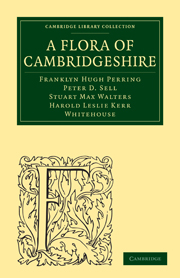Book contents
INTRODUCTION
Published online by Cambridge University Press: 03 May 2011
Summary
HISTORY OF THE STUDY OF THE FLORA
For three hundred years Cambridgeshire has been one of the best known counties, botanically, in the British Isles. The first list of plants made in the county was by Samuel Corbyn (1656), although a few records date from the sixteenth and early seventeenth centuries, made by men like Turner and How, who were beginning to study the flora of the country as a whole. However, the first work of real importance was that of the illustrious John Ray (cf. Raven, 1942), who in 1660 published a 12mo volume of 182 pages entitled Catalogus Plantarum circa Cantabrigiam nascentium. This has long been celebrated as the first comprehensive local British Flora. It was the result of nine years' work, and consists of an alphabetical list of plants found in the Cambridge area. It gives localities of plants, which in several cases can still be found there today, for example, Geranium sanguineum, ‘Found on Newmarket heath in the Devils ditch, also in a wood adjoining to the highway betwixt Stitchworth (Stetchworth) and Chidley (Cheveley)’.
In 1663 Ray published a 13-page appendix to the Cambridge Catalogue, and after this in 1685 appeared a second appendix consisting of 30 pages, edited by Peter Dent, a Cambridge apothecary. There was no second edition of the Cambridge Catalogue, but in 1670 Ray published his Catalogus Plantarum Angliae (ed. 2, 1677), in which all plants occurring in Cambridgeshire were marked with the letter C.
- Type
- Chapter
- Information
- A Flora of Cambridgeshire , pp. 1 - 30Publisher: Cambridge University PressPrint publication year: 2009First published in: 1964



